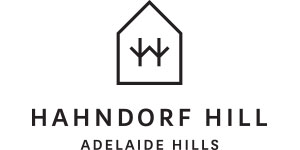
How did certain geographic regions become synonymous with quality? Why do sparkling wine producers fixate on Champagne; what is it about Piemonte wine that hypnotises dry red drinkers; and why do lovers of Gruner Veltliner obsess over the Wachau? There is a handful of regions around the world that are instantly recognisable to vinophiles and teetotallers alike as centres of excellence and prestige; and in this piece I will attempt to riddle out how this enviable status is achieved and, perhaps more critically, maintained.
Just as in most other professional spheres, long-term players in the wine industry rely on reputation; it is easy to write a poetic back label full of buzz words and hyperbole but the lazy and disingenuous are quickly exposed and relegated to the clearance bin. Socrates once said: “The way to gain a good reputation is to endeavour to be what you desire to appear”; in other words, in order to talk the talk, you must first walk the walk, and in the wine industry that can take generations.
There is no silver bullet or short cut to prestige, and there is also no one-size-fits-all template to follow, but there are three distinct denominators common to the elite regions that, when combined and strictly adhered to, can set the foundation for success.
- A commitment to regional typicity comes up again and again. Modern vintners are the beneficiaries of centuries of tweaking and tinkering; our forebears may not have fully understood the cause and effect of what they were doing but over time it has shaped our understanding of what works well where. This process of elimination evolved into styles embraced first by neighbours, then villages and eventually whole regions.
- Non-negotiable minimum standards are typically adopted informally at first, with producers of inferior wine expected to cop an earful from those trying to build a region’s reputation for quality. Later, DAC, DOCG and other modern statutory administrations were established to regulate and certify that a wine wishing to claim elite geographical provenance was made to the highest standards and in a manner consistent with the region’s values.
- A ‘we’ over ‘me’ philosophy is key. When like-minded people team up and work together towards a common goal, the whole becomes greater than the sum of its parts. Co-ordination and co-operation will always triumph over fractured self-interest.
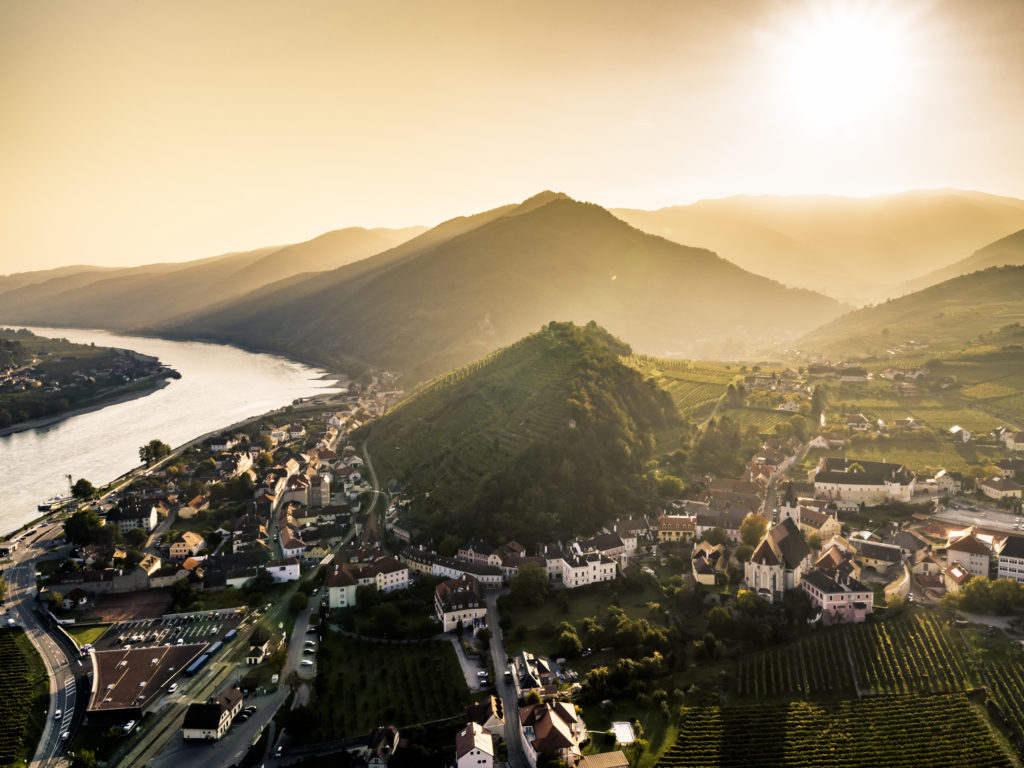
The perfect example of what can be achieved when these three tenets are embraced is the world-famous Wachau region in Lower Austria. The Vinea Wachau association was formed in 1983 by a group of Wachau growers and winemakers dedicated to protecting and promoting the valley’s reputation for quality; they restricted outside influence and mandated strict vineyard management and cellar practices through their Wachau Codex.
The Wachau Codex is a set of rules by which producers in the region who wish to trade on the valley’s fame must live and breathe; it consists of six iron-clad rules that govern every aspect of a wine’s viticulture and vinification and maturation. The goal is to ensure that the wines approved to bear its famous Vinea Wachau Nobilis Districtus badge were made in accordance with their incredibly exacting standards and will sing of their home in a clear and certain voice. The Codex classified the valley’s wine into three distinct styles.
‘Steinfeder’ is the lightest with a maximum alcohol level of 11.5% from early-picked grapes and is prized for its forward fruit and light airy elegance. This style takes its name from the wispy, gossamer-like Steinfedergras or ‘feather grass’ that grows between the vines. Wines classified as Steinfeder are fragrant and also lighter and leaner than those in the other categories.
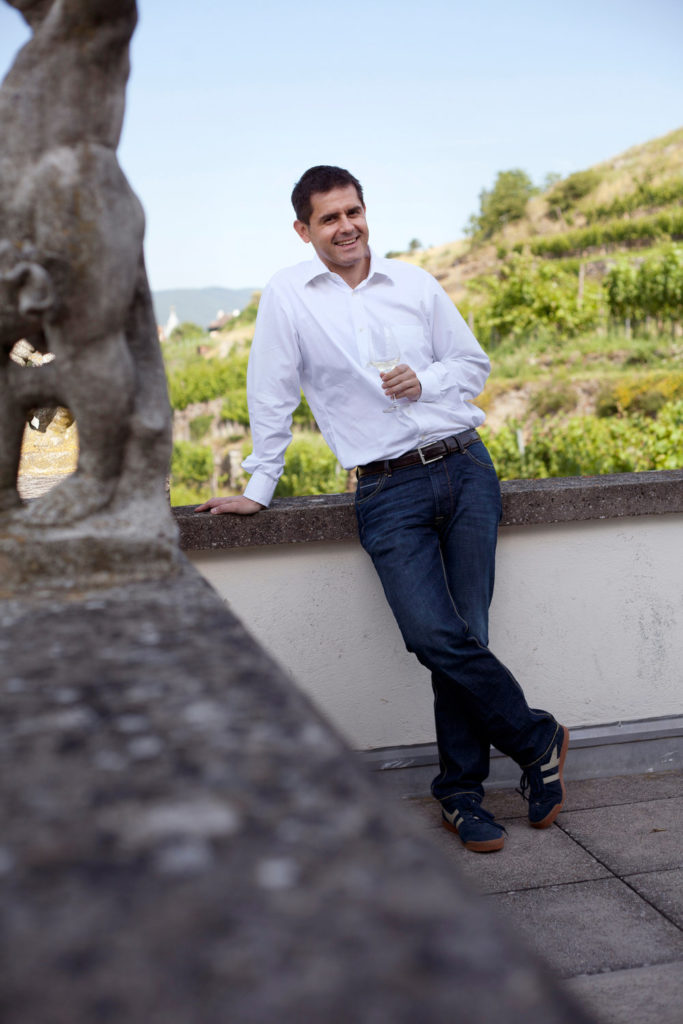
Wines in the second of the three classified styles are labelled ‘Federspiel’, which was the lure swung in circles high above one’s head to attract a hunting falcon back to its master’s heavy leather glove – falconry being a once popular sport amongst the Wachau nobility. Federspiel wines are restricted to alcohol levels of between 11.5% to 12.5%, an admittedly narrow band, but for a variety as nuanced as Gruner Veltliner there is still ample room for self-expression. Federspiel-style wines will lead with white pepper and orchard fruits such as apple and pear; and, according to Domane Wachau’s Roman Horvath MW, they can display a precise expression of terroir combined with a fresh, lively elegance.
‘Smaragd’ wines are the fullest and most textural of the Wachau; they are left to ripen longer on the vine and must have a minimum alcohol level of 12.5%; notice I said ‘minimum’ level as it is not unheard of for a Smaragd to reach as much as 15%. That may sound extreme but, when expertly handled, these powerful wines are still balanced and will routinely command top dollar across the world.
One of the captivating features of the Wachau – a Unesco World Heritage Site – are the dry-laid, stone-walled terraces that were hand carved into the valley’s impossibly steep walls. These narrow strips of flat land often no more than three metres wide were sculpted into the hillsides to create arable but only slightly more accessible land; each terrace is retained by a meticulously maintained stone wall. In addition to reinforcing the terraces, the stone walls help to reduce the threat posed by cold snaps; during the day they drink in the warm sun and in the cold of the night they gently radiate that heat back towards the vines. It is in these warm stone walls that a bright emerald or ‘Smaragd’ coloured lizard can be found soaking in the sun, and it is after this sun-loving lizard that the Wachau has named its ripest and richest wines.

Like all formal and structured classification systems, the Wachau Codex is complex and exacting; there are rules that govern every step from bud-burst to bottle and beyond, and I have quite deliberately only painted the broadest of strokes here because even Byzantium would marvel at the bureaucracy of a modern wine classification system. I would much rather line up examples of each style and drink them; that is after all, what they are for!
We in Australia are very fortunate to have several elite examples of the Steinfeder style easily available, one of which is the 2016 Emmerich Knoll Loibner Steinfeder Gruner Veltliner. Emmerich Knoll Senior, father of current winemaker Emmerich Jnr, was a founding member of the Vinea Wachau association and contributed heavily to the Wachau Codex. A deeply instilled sense of place and rock-solid commitment to excellence has propelled Weingut Knoll to the highest echelons of Austrian winemaking; few have earned such a prominent reputation and even fewer work as hard to keep it.
The Knoll family were well established in the Wachau winemaking scene long before they released the first bottles of their own wine in the 1950s; in the decades that followed the business grew and demand for their wines expanded globally. The now classic label featuring a baroque style image of Saint Urban, the patron saint of winemakers, was created in 1962 and is now the cover letter to the most impressive CV you can read.
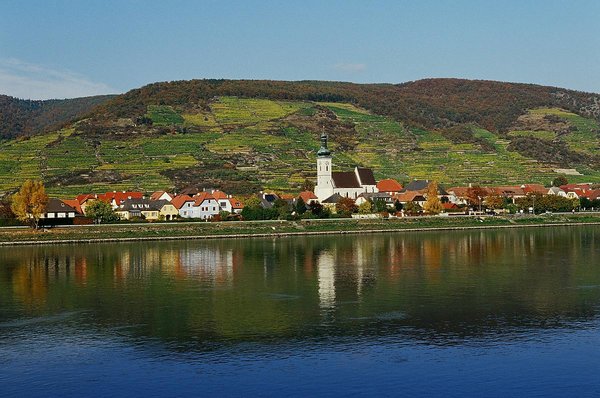
Their 2016 Loibner Steinfeder Gruner Veltliner sources its fruit from several carefully selected sites from the twin villages of Unterloiben and Oberloiben. Ripe white stonefruit and summer blossoms make up the nose and front palate, delicate spice and custard apple soon join in and a Pinot Gris like mouthfeel rounds out the party. This wine initially presents as rather simple and brief but a patient drinker who takes their time and affords the wine an opportunity to stretch its legs, will be rewarded with bonus layers of texture and complexity. The spirit of the Steinfeder style is to be fresh, friendly and approachable; this wine is all those things and more. This lighter style which promotes its fruit and sprightly enthusiasm is the perfect match for char-grilled or spicy foods, especially Indonesian and Malaysian cuisine.
Domane Wachau, a smart wine cooperative, is the largest producer in the region and has been in the vanguard of Austria’s emergence onto the international stage. Established in 1938, the business is now managed by winery director Roman Horvath MW and winemaker Heinz Frischengruber, two men for whom authenticity and a faithful interpretation of terroir is paramount. In conjunction with its 250 growers and partners, Domane Wachau strives to make the most of hard-won lessons learned by preserving the traditions and culture of their region whilst always forging forward.
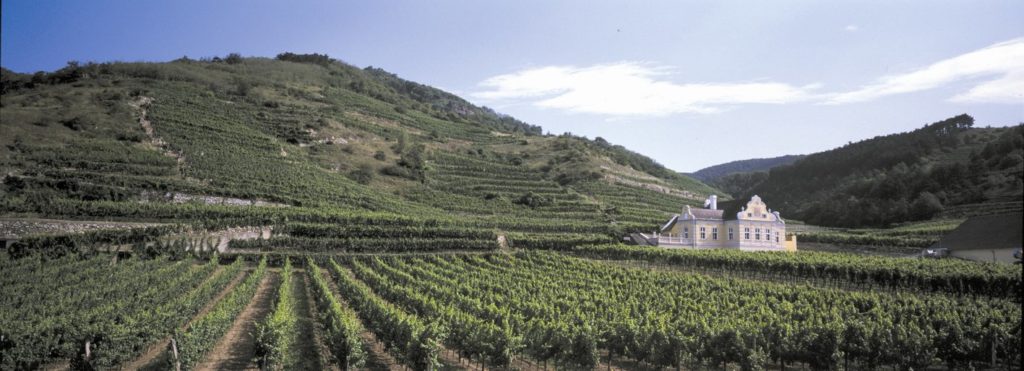
Domane Wachau sources fruit from a great many of the region’s most acclaimed vineyards and produces a number of wines in each of the three classified styles, but I have chosen to write about their Reid Kaiserberg Federspiel Gruner Veltliner for two reasons: firstly, because it is readily available in Australia, and secondly, because I know it to be delicious.
On my first trip to Austria in 2017, I visited the beautiful town of Durnstein which hugs one of the many bends of the Danube river, about thirty minutes’ drive west of Krems. While there I visited the Domane Wachau cellar door and was immensely impressed; the modern building sits on one of the few stretches of flat land between the towering hillsides and surging Danube River and blends seamlessly with its medieval surroundings. It was here that I was guided through a tasting tour of their wines and the region’s long history by the welcoming, generous and knowledgeable staff.
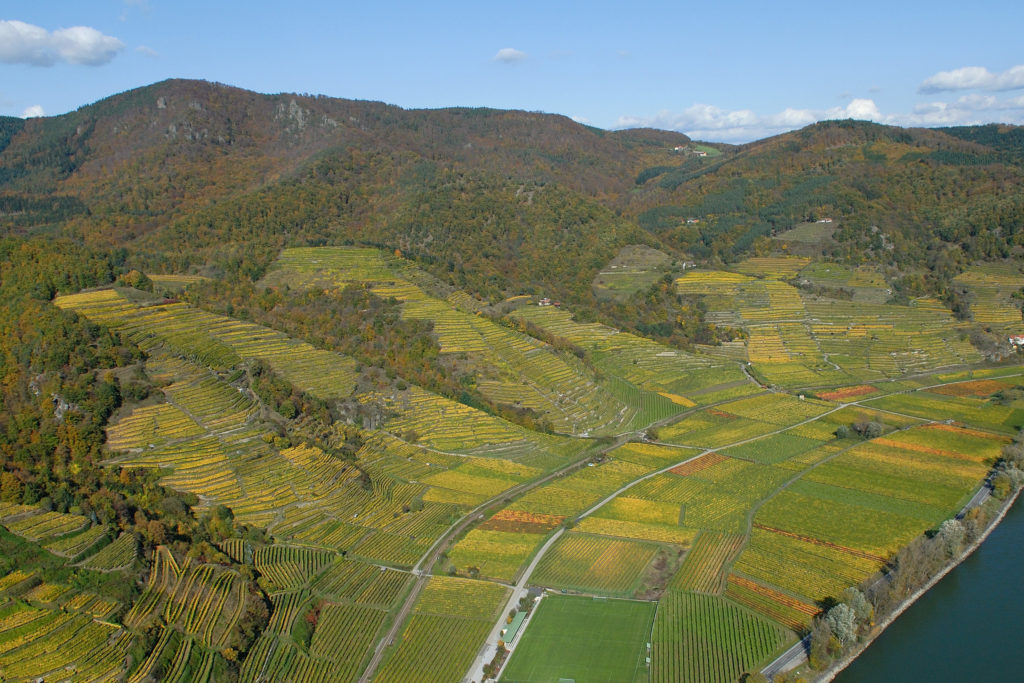
The first documented reference to a vineyard on the Kaiserberg slope is from 1450 AD and the Emperor Charlemagne is said to have camped his army on the spot around 800 AD, but both of these dates are mere heartbeats in the site’s full history which spans epochs. Volcanic rock created under extreme heat and pressure was later semi-buried by metamorphic rock dragged into the valley by ancient ice-age glaciers. This mineral-rich, rocky soil and the unique Pannonian influence on the climate make this particular bend in what is a very bendy river an especially prime place to grow Gruner Veltliner in the Federspiel style.
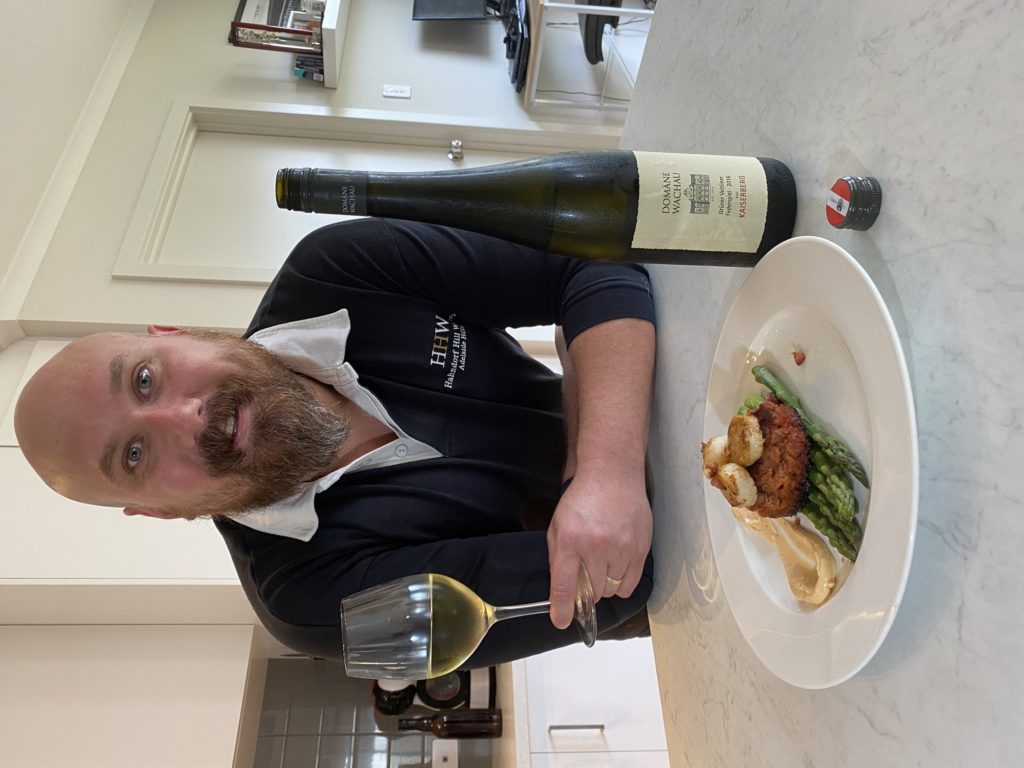
The 2016 Domane Wachau Kaiserberg Federspiel Gruner Veltliner has ticked every box required of an elite Federspiel; pale straw in colour and with a nose humming with green apple, ripe Tahitian lime and a hint of allspice. The palate has presence, nuance and is perfectly balanced between citrus, custard apple, nectarine, white pepper and anise. This is the perfect wine to pour for a Riesling tragic; if this doesn’t open their eyes to new possibilities, nothing will. I would love a glass with a rare steak or a slab of crispy pork belly but it is especially delicious with scallops; here I paired it with blanched asparagus, scorched chorizo and butter-seared scallops. When I tasted them together the whole world just fell away; I went to a place free of Coronavirus, kids on school holidays and even that demonic mosquito that has moved into my bedroom. A very happy place indeed.
In its 122-year history, the winery of FX Pichler has seen a lot. Small localised challenges and worldwide crises have tested the family but nothing has shaken its passion for, and commitment to, the Wachau. A quick glance at their portfolio, which is heavy with the most challenging style classified in the Wachau Codex, is all the proof you need to know that they mean business. Current winemaker Lucas Pichler took over the reins in 1999 from his father, Franz Xaver, and under his stewardship the brand has gone from strength to strength.
A ‘Smaragd’ wine is the most challenging style to produce because it requires the fruit to have achieved maximum physiological ripeness before being picked by hand; this is exceedingly risky because as the season progresses the chance of adverse weather becomes much higher. When fully ripe it doesn’t take much for fruit that looks perfect at breakfast to be ruined by dinner. Despite this risk, FX Pichler are so firm in their belief that much of their land wants to produce Smaragd-style wines, that they have persevered with this tradition for decades – and with spectacular results.

The 2017 FX Pichler Durnsteiner Smaragd Gruner Veltliner, with its 14% alcohol volume, is a masterclass in texture. The fruit which is sourced from several small plots around the village of Durnstein is treated to extended time on skins before wild fermentation and then left to mature in large oak casks before being bottled without fining. This slow and steady approach gives the fruit time to collect its thoughts and compose a tribute to its birthplace. Golden peach, pear and apple are partnered with creamy vanilla and white pepper spice which build and build to peak in crescendo. Just as the character of Calaf rallies in his stirring aria, Nessun Dorma, in Giacomo Puccini’s opera Turandot, this wine left me elated, energized and exhausted (in a good way).
Three distinctly different wines which, in my opinion, represent the elite of three distinctly different styles. So much variation and nuance but still consistent and representative and that is the key. Co-ordination and co-operation are critical but so is having the flexibility to work with the whims and mood swings of Mother Nature. The Wachau, united in common purpose, institutionalised a set of practises and procedures that enshrined what they value: purity, provenance and regional typicity; and by having three distinct classifications they have allowed themselves enough room to make world-class wine and still embrace their unique set of variables.
Almost 40 years ago, the producers of the Wachau took it upon themselves to install a system that would highlight their assets and protect their legacy; this system and its participants’ steadfast commitment to it, have served to shield the region from reputational harm. This was a gift from one generation to another. Today’s producers now reap the benefits of their fathers’ and grandfather’s vision – but to rest and think the job done is not the Wachau way.
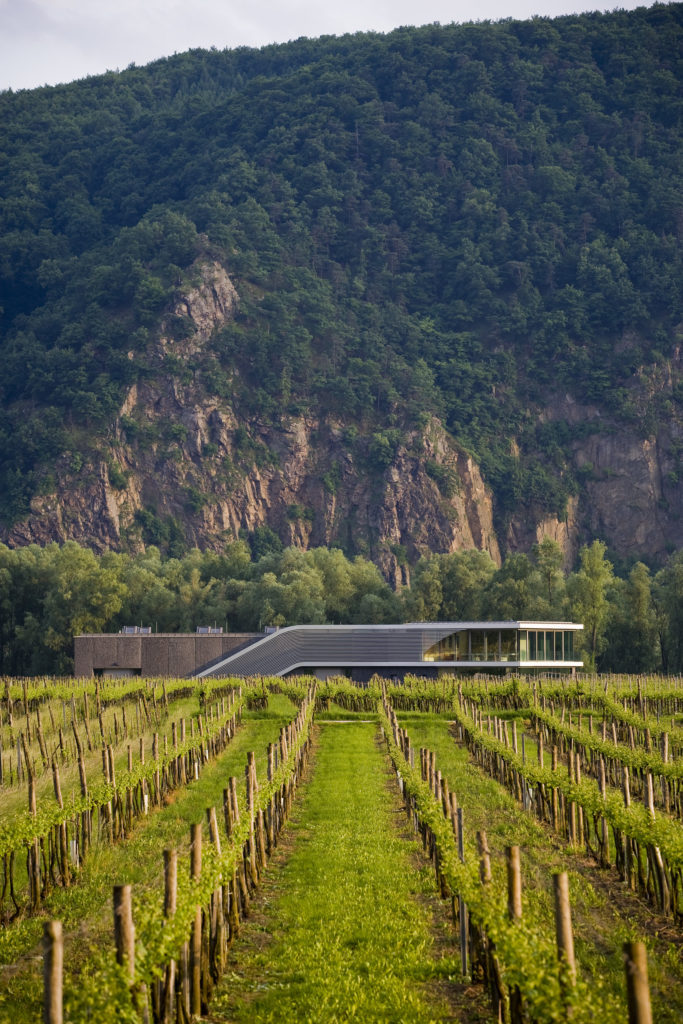
The gospel-like Wachau Codex is now evolving and the ink has dried on a formal DAC (Districtus Austriae Controllatus) agreement, which aligns the Wachau with Austria’s other wine regions under the aegis of the country’s national wine classification system. As of the 2020 vintage, eligible wines will bear the title of Wachau DAC. The Codex category titles of Steinfeder, Federspiel and Smaragd will still be used as stylistic guides, while the DAC’s focus on place of origin will better guide the consumer through the region’s 22 registered villages and 157 elite single vineyards. The hope is that the established Wachau Codex with its focus on vineyard management, vinification and distinct styles, and the new DAC structure with its emphasis on geographic definition, will act as two sides of the same coin and ultimately complement each other; a case of the whole becoming greater than the sum of its parts.
The great regions did not achieve their renown overnight, nor was it easy. It took generations of hard-working visionaries who refused to take short cuts and instilled in their children the passion and discipline to maintain that most hard won of things: a good reputation.
Prost, Jack.
